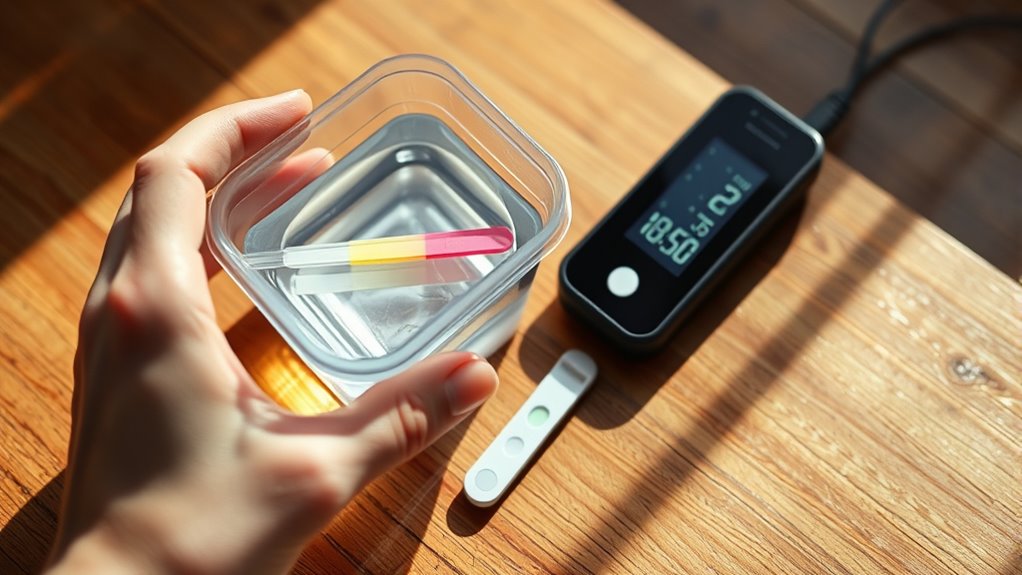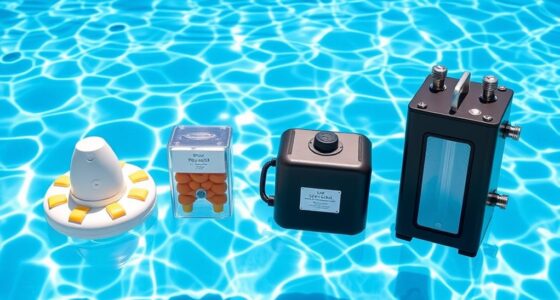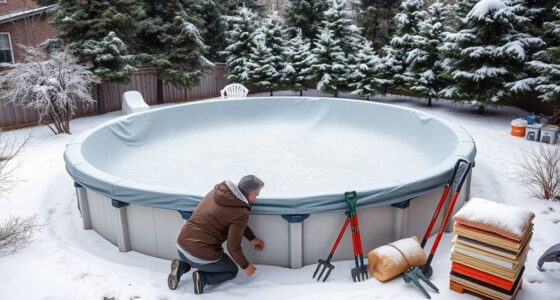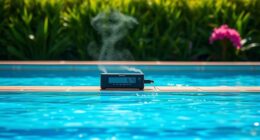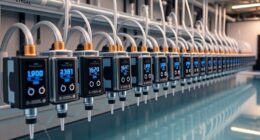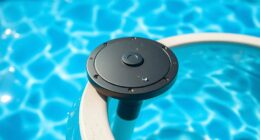When choosing water testing methods, you’ll find that test strips are simple, affordable, and give quick color-change results, making them ideal for basic screening. Digital testers, however, provide more accurate, numerical pH readings and can detect a wider range of contaminants, suitable for detailed analysis. Your choice depends on how precise and thorough you need the results, as well as your budget. Keep exploring to discover which method best fits your specific water testing needs.
Key Takeaways
- Test strips are affordable and quick, ideal for basic screening, while digital testers provide precise, numerical results for detailed analysis.
- Digital testers detect a wider range of contaminants with higher accuracy but require calibration and maintenance.
- Test strips offer a simple visual indication of water quality, whereas digital devices give objective, numerical data.
- The choice depends on application needs: strips suit quick checks; digital testers are better for detailed, professional assessments.
- Regular calibration and proper sampling are essential for accurate results from digital testers; strips are more user-friendly but less precise.

Water testing methods are essential tools for safeguarding the safety and quality of your water supply. Whether you’re checking well water, pond water, or tap water, knowing how to test accurately can make a big difference in protecting your health. Two popular testing options are test strips and digital testers, each with their own advantages and limitations. Understanding how they handle pH measurement and contaminant detection will help you choose the right method for your needs.
Test strips are straightforward, affordable, and quick to use. When you dip a strip into your water sample, it reacts with specific substances, producing a color change that indicates the presence of certain contaminants. For pH measurement, color-coded strips are common, allowing you to compare the strip’s hue to a chart and determine the water’s acidity or alkalinity. While simple to operate, test strips may not provide the most precise readings, especially if the colors are ambiguous or if the water’s chemistry is complex. They are effective for general screening but might miss trace contaminants or subtle pH differences, which are critical for certain applications such as aquaculture or drinking water safety.
Test strips are simple, affordable tools for quick water quality screening.
Digital testers, on the other hand, utilize electronic sensors to analyze water samples. These devices often come with probes that measure pH with high accuracy, providing numerical readouts rather than color comparisons. This precision makes digital testers ideal for monitoring pH levels where exact measurements are essential, like in laboratory settings or for sensitive industrial processes. Digital testers also excel at contaminant detection, especially when equipped with specific sensors or test modules designed to identify heavy metals, nitrates, or other pollutants. They can detect a wider range of contaminants more reliably than strips, often with lower margins of error. However, digital testers tend to be more costly and require regular calibration and maintenance to uphold accuracy over time.
Choosing between strips and digital testers depends on your specific needs and budget. If you want a quick, low-cost screening tool for general water quality checks, test strips are convenient and easy to use. But for detailed, precise measurements of pH or comprehensive contaminant detection, investing in a digital tester pays off by providing more dependable data. Proper sampling, calibration, and following instructions carefully are key to obtaining accurate results. Regular testing and understanding your water’s chemistry help you make informed decisions about water safety, protecting your health and guaranteeing the water you use is clean and safe. Additionally, understanding the contrast ratio of your testing equipment can influence the clarity of your results, especially in visual assessments.
Frequently Asked Questions
How Often Should I Test My Water Quality?
You should test your water quality at least once a year, but testing frequency depends on contamination sources nearby. If you notice changes in taste, odor, or color, test more often. Regular testing helps identify potential risks early and guarantees safe water. Using reliable methods like digital testers or strips can give you quick results, so stay vigilant and adapt testing frequency based on your environment and any new contamination sources.
Are Digital Testers More Accurate Than Strips?
Think of digital testers as sharp-eyed scouts and strips as trusty maps. Digital testers generally offer better digital accuracy, giving you quick, precise readings. However, strip reliability can vary, especially if not stored properly or used correctly. So, while digital testers often provide more accurate results overall, both tools have their place. You’ll get the best results by understanding their strengths and using them appropriately for your water testing needs.
Can Testing Methods Detect All Water Contaminants?
Testing methods can’t detect all water contaminants because of their limitations. While digital testers and strips effectively identify common issues like pH, chlorine, or nitrates, they often miss more complex or low-concentration contaminants like heavy metals or certain chemicals. You should understand testing limitations and consider extensive testing or lab analysis for a complete contaminant detection, especially if you suspect specific pollutants or have health concerns.
How Do Environmental Factors Affect Test Results?
Environmental interferences and seasonal variations can notably skew your water test results. Imagine testing during a rainy season—heavy runoff might introduce contaminants, making your readings unreliable. Cold temperatures or direct sunlight can also affect digital testers’ accuracy, leading you to false positives or negatives. Always consider these factors, as they can mask or mimic water issues, causing you to misjudge your water quality and potentially overlook real problems.
What Is the Typical Lifespan of Water Testing Strips?
You can expect water testing strips to last about 1 to 2 years if stored properly. Their shelf life depends on storage conditions—keep them in a cool, dry place away from direct sunlight and humidity. Poor storage can diminish their accuracy and effectiveness. Always check the expiration date on the packaging, and use them within the recommended timeframe to ensure reliable test results.
Conclusion
Choosing between test strips and digital testers is like picking between a trusty map and a GPS—each guides you, but your choice depends on your needs. Test strips are quick and simple, like a quick snapshot, while digital testers offer detailed insights, like a detailed landscape. Whichever you pick, remember, you’re the captain of your water’s story. With the right tool, you’ll navigate clarity and purity, turning uncertain waters into a crystal-clear voyage.
